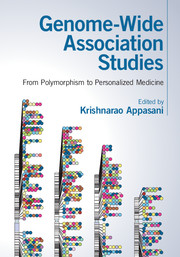Book contents
- Frontmatter
- Dedication
- Contents
- List of contributors
- Forewords
- Preface
- List of abbreviations
- Part I Genome-wide association studies
- Part II Genome-wide studies in disease biology
- Part III Single nucleotide polymorphisms, copy number variants, haplotypes and eQTLs
- Part IV Next-generation sequencing technology and pharmaco-genomics
- 15 Next-generation sequencing for rare diseases
- 16 Next-generation sequencing for complex disorders
- 17 Chromosomal breakpoints in breast cancer co-localize with differentially methylated regions
- 18 Signaling network analysis of genomic alterations predicts breast cancer drug targets
- 19 Pharmacogenetic studies in pediatric acute myeloid leukemia
- 20 Pharmaco-genomics of antiretroviral drugs
- Part V Population genetics and personalized medicine
- Index
- Plate section
- References
19 - Pharmacogenetic studies in pediatric acute myeloid leukemia
from Part IV - Next-generation sequencing technology and pharmaco-genomics
Published online by Cambridge University Press: 18 December 2015
- Frontmatter
- Dedication
- Contents
- List of contributors
- Forewords
- Preface
- List of abbreviations
- Part I Genome-wide association studies
- Part II Genome-wide studies in disease biology
- Part III Single nucleotide polymorphisms, copy number variants, haplotypes and eQTLs
- Part IV Next-generation sequencing technology and pharmaco-genomics
- 15 Next-generation sequencing for rare diseases
- 16 Next-generation sequencing for complex disorders
- 17 Chromosomal breakpoints in breast cancer co-localize with differentially methylated regions
- 18 Signaling network analysis of genomic alterations predicts breast cancer drug targets
- 19 Pharmacogenetic studies in pediatric acute myeloid leukemia
- 20 Pharmaco-genomics of antiretroviral drugs
- Part V Population genetics and personalized medicine
- Index
- Plate section
- References
Summary
Introduction
Acute myeloid leukemia (AML) is a clonal disorder characterized by appearance of immature, abnormal myeloid cells in bone marrow and other organs. AML accounts for around 15–20% of childhood leukemias. AML is a very heterogeneous disease with various subtypes classified based on the morphology, immunophenotype, and cytogenetics. In spite of advances in recent years, the 5-year survival rates for AML are ~68% for children younger than 15 years and ~57% for children between 15 and 19 years. The utilization of multiple clinical, cytogenetic, and other molecular features that are associated with response has helped in the identification of a patient being more or less likely to respond. Additionally, minimal residual disease (MRD after induction 1) has been identified as a powerful predictor of poor outcome. The nucleoside analog cytarabine (ara-C) has been the mainstay of AML chemotherapy for more than 40 years. However, extensive inter-patient variation in treatment response, development of resistance, and inadequate response to first-line therapy remain the major hurdles to effective chemotherapy. Patients within standard and high-risk categories often experience induction failure and have early relapse, warranting the need for better diagnostic and therapeutic strategies. One of the critical components contributing to the efficacy of the chemotherapeutic agents is variability in the expression and/or activity of genes involved in drug pharmacokinetics and pharmacodynamics. This chapter summarizes the recent advances in pediatric AML pharmacogenomics.
Pediatric acute myeloid leukemia
Leukemia is the most common cancer among children, with acute lymphocytic leukemia being the most common and AML being the second most common leukemia in children. Approximately 800 new cases of childhood AML are diagnosed in the US annually (Meshinchi and Arceci, 2007; Pui et al., 2011). AML is a clonal disorder originating from a hematopoietic stem cell or lineage-specific progenitor cells (Jordan, 2007; Lane et al., 2009). The malignant transformation of the stem or progenitor cells results in the accumulation of immature myeloid cells in the bone marrow and other organs. Prognostic factors help in strategizing the treatment regimens for patients with less or more likelihood of response. As indicated before, AML is a very heterogeneous disease with several subtypes that differ from one another in morphology, immunophenotye, and cytogenetics.
- Type
- Chapter
- Information
- Genome-Wide Association StudiesFrom Polymorphism to Personalized Medicine, pp. 281 - 296Publisher: Cambridge University PressPrint publication year: 2016



